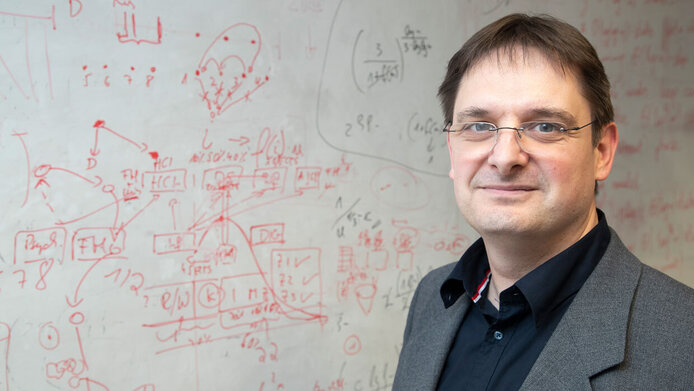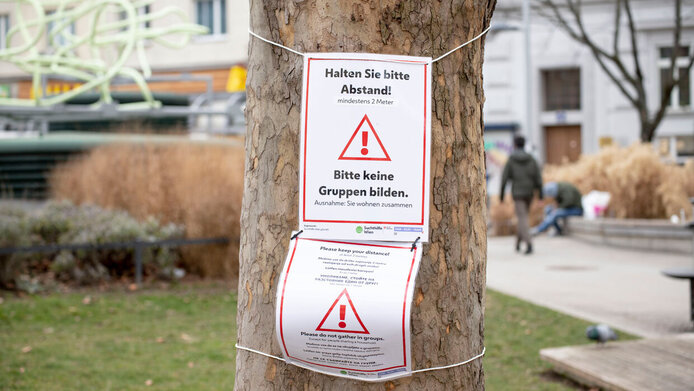Further reading
- Why social distancing is painful
- Coronavirus: families at breaking point?
- The social fever curve of coronavirus

Whether it is climate and traffic research or – as for the past year – the fight against a global pandemic, it will inevitably involve computer simulations. The world has become too complex to manage without the enormous calculating power of computers. In the coronavirus pandemic, the work of researchers who have specialised in this field has moved into the public limelight and has made them frequent invited guests in the media. This does not come as a surprise, because their simulations form an important basis for political decisions such as relaxing or tightening measures to contain the pandemic. Robert Elsässer, a mathematician and computer scientist at the University of Salzburg, is one of those experts who are calculating what effect certain measures will have on the infection incidence.
Robert Elsässer and his team have been investigating the spread of diseases in large populations for several years. As an expert in algorithms, he develops methods to solve distribution problems in dynamic systems. One fundamental problem in large networks is the distribution of information. And in this respect there is a surprising similarity: the spread of viruses in a population often resembles the way in which information spreads in a network. In the fight against pandemics, science can profit from this fact. As early as back in 2004, Elsässer’s team began researching the spread of flu-like processes, which showed astonishing similarities to the real-life medical data from the Robert Koch Institute. When Covid-19 broke out a year ago, the researchers were able to use these results as a basis and after a few adjustments – such as additional types of infection – they were able to make the first data available quickly.
This example shows that many scientific developments in this year of the pandemic have been achieved so quickly not only because the pandemic has been a focus area for researchers and funding, but even more so because basic research has been preparing the scientific ground for decades. The first vaccine against Covid-19 was approved at the end of 2020, only months into the global spreading of the pandemic. But the underlying research for mRNA vaccines of that type had gone on for decades and was originally intended to serve goals completely different from antiviral vaccines – namely a vaccine against cancer. A promising drug against Covid-19 from the Viennese company Apeiron is currently going through clinical testing and is showing good results. The founder of Apeiron, the molecular biologist Josef Penninger, started basic research on the development of this antiviral drug 20 years ago.
How does the simulation expert see the current situation in Vienna? In the spring, after a year of social distancing, working from home, permanent worries for families about childcare and financial worries, new hopes arose for the exhausted population. On 21 March 2021, Vienna’s City Councillor for Health, Peter Hacker, announced his intention to allow outdoor dining at the end of March despite rising infection figures. “We can’t keep the population locked up any longer,” he said. But, as so often in this last year, things took a different turn. Intensive care units in hospitals in eastern Austria were working at full capacity, the government put on the emergency brake and decided to tighten measures, at least for the east of Austria. On 24 March, the new measures were announced: these involved compulsory wearing of FFP2 masks in all enclosed public spaces, testing in companies, more working from home, closing of retail stores and all school students returning to distance learning after the Easter holidays. The hard lockdown was finally extended until the beginning of May.
Robert Elsässer is Professor of Computer Science at the University of Salzburg. He studied computer science with a minor in mathematics at the University of Paderborn/Germany, received his PhD in computer science there in 2002 and was then appointed junior professor. In 2012 Elsässer took up a position at the University of Salzburg, where he heads the Efficient Algorithms Group. His research focuses on parallel and distributed algorithms as well as the structure of graphs and networks.
Robert Elsässer expects a decisive positive effect from more people working from home and the planned company testing. “I think testing in companies makes a lot of sense, and it should involve several tests a week in order to break advancing waves of infection within short intervals,” Elsässer noted at the end of March. Here, one could combine different test variants, e.g. PCR gargle tests once a week and the less reliable antigen rapid tests every two days. His team could see the “breakwater effect” of this measure very clearly in the simulations – provided the quarantine regulations are consistently adhered to. Elsässer is rather sceptical about extending the FFP2 mask requirement to offices: “In the long run, the mask can reduce workers’ performance.”

Elsässer considers the fact that the measures are limited to one part of the country understandable from the political point of view, but not optimal in epidemiological terms: “It is probably only a question of time until hospitals in other parts of Austria reach their capacity limits.” Elsässer also has little sympathy for compulsory entry tests for retail shopping: he thinks wearing FFP2 masks consistently should be enough.
The simulations conducted by Elsässer’s team focus on the transmission of viruses indoors, more specifically in schools, workplaces and families. In a letter to the German government, in mid-April 2021, experts from the German Society for Aerosol Research (GAeF) also recommended focusing on indoor areas, as this is where “the vast majority of infections” occur. They made reference to international studies about this aspect. Outdoors, infections occur predominantly via droplets – and keeping at a distance and wearing FFP2 masks provides protection against that.
Elsässer takes the data for his calculations from the relevant medical literature. Important parameters include the proportion of people working from home, the extent of distance learning, the distribution of office types broken down by the number of people working in them, compliance with quarantine measures and the age structure.
Elsässer primarily used details from the city of Salzburg as a database, but there were no major differences compared to national data for Austria. He does feel, however, that it is important to examine a relatively closed area, such as a conurbation. “Our simulations are very well suited for cities like Salzburg, Vienna or Linz and less well suited to rural regions.
The results of the calculations at the beginning of January clearly showed the following: with schools operating normally without measures such as testing and alternating shifts and a home office rate of 30 to 60 percent, it is not possible to prevent an increase in infections even under optimistic assumptions. A soft lockdown is only effective when 40 percent of the population is already immune.
The picture shown by the latest simulations from late March is no longer completely unequivocal. These results take into account the virus mutations that are more infectious by 25 to 50 percent and the measures as they applied before Easter, i.e. schools in shift operation with testing, retail and close-contact service providers open under specific distancing rules. “If we assume testing in schools, and that 50 percent of positive children are detected and go into quarantine together with their families – on condition that everyone adheres to the measures and that infections only occur in schools, in families and in businesses – then these measures would be sufficient even with the more infectious virus mutation,” says Elsässer. The problem: the many ifs and unknowns.
If not everyone complies with the rules and if there is even a slight mathematical deviation from these assumptions of only 0.02 percent, the infection rate will rise again. The unknowns in the situation stretch the mathematical models to their limits. It is allowed, for instance, for two households to meet. But how often does that happen and how many households of what size do actually meet? It is difficult to map this in simulations. “But this one unknown is enough for an increase in infections,” says Elsässer.
Even at school, mathematics was Elsässer’s favourite subject. He grew up in Transylvania, Romania – his ancestors were members of the ethnic group of Banat Swabians. After the political turnaround he emigrated to Germany at the age of 19 and majored in computer science with a minor in mathematics at the University of Paderborn. What he has always particularly appreciated in his new home country is the freedom of opinion. Having grown up in a totalitarian regime where even a joke about the government could cost you your freedom, 49-year-old Elsässer sees democracy as an invaluable asset. “I still cannot get my head around the fact that it is even possible to suppress an entire population in such a way,” he says, recalling his childhood in the neo-Stalinist dictatorship under Nicolae Ceausescu.
Robert Elsässer is one of those researchers who have moved into the limelight in the course of the coronavirus pandemic. An experience that involves both light and shadow. On the one hand, he is pleased about the generally increased interest in his work, which he has been pursuing for decades, and that he can make a contribution to overcoming a health and social crisis. On the other hand, there are also nasty comments on newspaper interviews and personally insulting mails from corona deniers. Corona – a time characterised by contradictions.